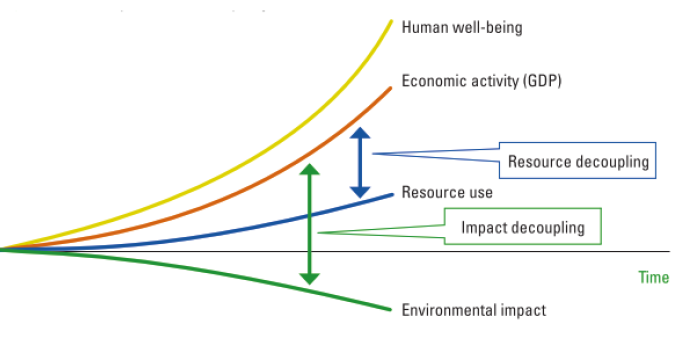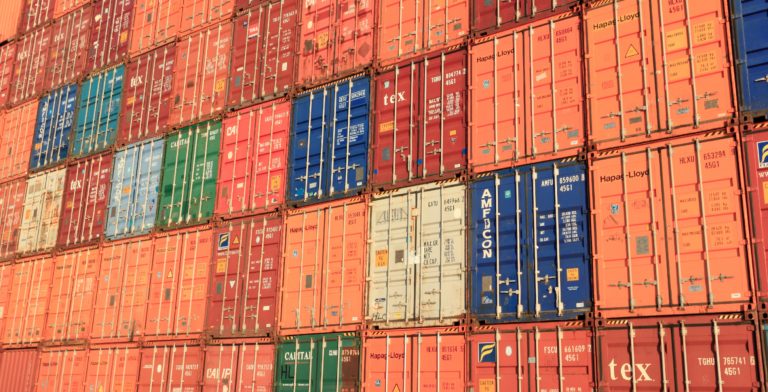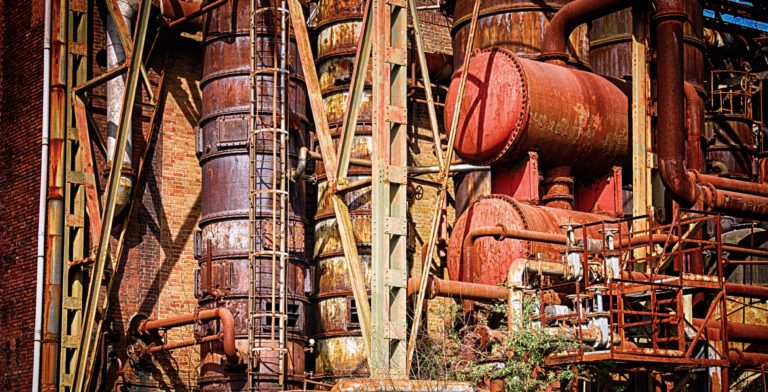What is decoupling and why is it important?
Economic growth is considered a fundamental goal and a precondition for human development. Economic activities, however, go hand in hand with environmental hazards. Activities that involve extraction of raw materials, transformation into products, distribution, consumption of goods and services and disposal require also other resources such as land or water and produce waste or GHG emissions.
The global economy depends on a broad range of raw materials. These encompass non-renewables like fossil fuels, which are mainly used for energy production, or industrial and construction minerals and metals ores required for infrastructure or manufacturing. Also renewables, i.e. different types of biomass, play an important role – not only as the basis for food products but increasingly also for bio-based products such as fibers, oils or textiles (e.g. for the “bioeconomy”). Gathering information on global material consumption is of high relevance, as many of today’s most pressing environmental problems such as climate change, biodiversity loss or water scarcity are directly linked to the scale of our material throughput.
Global economic development has come along with a steady increase in global material use reaching a level that threatens the sustainable functioning of the earth’s ecosystems. Contradictory, societies keep on striving for economic growth as the main driver for development. A discussion about this momentous issue has begun on various political levels and has also been taken up into the Sustainable Development Goals (SDGs) calling for a harmonization of economic and environmental goals (e.g. SDG 8).
The most prominent concept to harmonize economic and environmental goals is to decrease the requirement of natural resources for ongoing economic performance. In other words, to break the link between “environmental bad” and the “economic good” (OECD, 2015). This “decoupling” process would allow economic prosperity while reducing environmental pressures and impacts and, furthermore, would enable human development in accordance with planetary restrictions.
How is decoupling measured?

Source: UNEP (2011)
The concept of decoupling is differentiated into breaking the link between economic growth and resource use (resource decoupling), and the link between economic growth and environmental pressure (environmental decoupling) (see Figure above). Currently, the decoupling debate focuses on resource decoupling in production processes, i.e. increasing resource efficiency, following the assumption that by that means also environmental impacts will be lessened.
When evaluating decoupling trends, two types of decoupling can be distinguished: Relative decoupling is achieved when economic growth is exceeding growth in material use. In contrast, achieving economic growth while at the same time decreasing overall material use is called absolute decoupling. While both cases entail an increase in efficiency in raw material use, only the latter can be seen as a means towards lowering the pressures on the environment.
As uniform measuring standards are not adopted yet, decoupling trends are monitored applying a series of different indicators – and underlying databases. Depending on the perspective taken and indicator applied, the results of decoupling analyses can diverge considerably.
Currently, no uniform standards have been adopted yet to measure decoupling trends. Typically, economic performance (GDP) is compared with resource use within one productivity indicator. For instance, in the EU Roadmap to a Resource-Efficient Europe the main indicator used is GDP divided by Direct Material Consumption (DMC). Discussions are still ongoing, if material use should be represented by an indicator also taking account of supply chain-wide material inputs, like the indicator Material Footprint (MF, also called RMC). However, only if the economic and physical indicator are disclosed separately, a meaningful statement about the achievement of decoupling can be made.
Decoupling around the World?
Following this global challenges and ongoing political efforts, the question arises whether economic growth actually decouples from material use on a global level or even perhaps in particular world regions.
Monitoring the time period 1990 to 2024, a simultaneous growth of natural resource extraction, population and GDP on the global level can be seen. As described, the comparison of material extraction with economic performance provides an insight in trends of material intensity and material productivity (the reciprocal value of material intensity) as well as of decoupling of the global economic system over time.
In the years of 1990 to 2002, the GDP growth rate exceeded the material extraction rate globally, representing a trend of relative resource decoupling. From 2002 on, this trend of increasing material productivity stagnated and from 2009 on it inverted. To understand this turnaround, the role of financial market stability needs to be highlighted. The economic and financial crisis caused a downtrend of the global GDP from 2008 to 2009. In contrast, overall material extraction continued to increase rapidly, as emerging economies like China, India, or Indonesia entered were struck less hard by the crisis and entered a period of enormous growth rates resulting in intensified material use. In 2014, global material productivity started to increase again, with a moderate dip in 2020. During this year, the impact of the COVID-19 pandemic on global GDP growth was more distinct than on the growth of material extraction.
Note: Hover over the graph to view the respective values. To access and modify this visualisation open it via the visualisation tool.
Decoupling in particular world regions?
World regions and countries differ among each other with regard to their raw material endowments, paving the way for intensive trade routs. Countries less endowed with raw materials but ongoing material demand satisfy their needs through raising imports. Furthermore, it can be observed that wealthy nations tend to outsource production, which require low-wage labour or come along with environmental hazards. When analysing decoupling trends of different countries, using the MF indicator conveys a different message than when applying the DMC indicator, as the former takes into account all the raw materials needed to feed the supply chains ending in a country’s consumption. For a comparison of the DMC and MF indicator see our specific story.
Decoupling trends can best be illustrated by plotting the development of national GDP (x-axis) against the trend of material consumption expressed in DMC or MF (y-axis). It can be seen that some countries managed to achieve even absolute decoupling of GDP growth from their DMC. In most of the cases this can be explained by three causes: First, technological improvement lead to increased resource efficiency. Second, the economic structure changed towards service sectors that are characterized by less direct material input per economic output, and lastly – the probably most significant factor – material-intensive economic activities were outsourced to other countries through international trade. Typical examples are Germany, Japan or the United Kingdom, which show economic growth while decreasing their DMC. In Germany this trend can be seen since the year 1970, in Japan and the United Kingdom it started in the year 1973.
Other countries, with large raw material endowments, show a strong increase in DMC over time. Examples are Malaysia, Brazil, and Australia with increases by 1450%, 450%, and 120%, respectively since 1970. While Malaysia and Australia show relative decoupling, Brazil started with relative decoupling, but re-coupled from 1975 onwards.
However, when switching from DMC to MF the picture changes for some countries. Especially the industrialised countries show an increase in MF (e.g. UK), in contrast to the DMC development. Countries with large resource endowments like Chile show similar but less pronounced trends of MF in comparison with DMC, as the former allocates material extraction needed to produce, for instance, metal exports to the importing country. Only a few countries achieved absolute decoupling of MF from economic development in the period 1992-2021. For instance, Germany managed to slightly reduce its MF while maintaining economic growth.
The large differences between MF and DMC trends and, in connection with them, between decoupling trends highlight the disparity of material consumption among world regions and countries and implies a shift of extraction activities from developed to emerging economies. This can be seen even clearer when comparing absolute numbers (instead of trends). Thus, decoupling should not focus on decreasing material intensities only, but also ensure an absolute decrease of material extraction processes among all world regions.
Note: Hover over the graph to view the respective values. Find this graph and related visualisations in the productivity section of the Country Profiles. (Select country of interest, tab ‘Productivity’).


